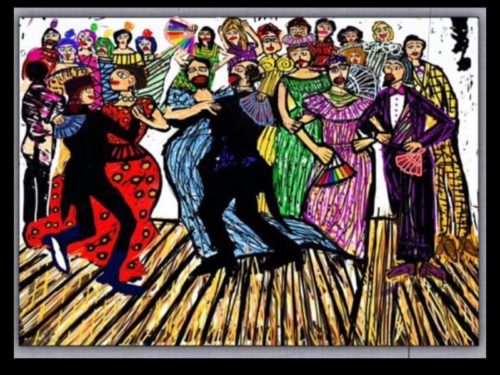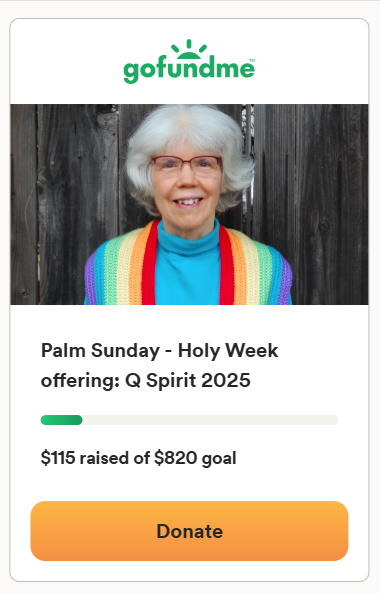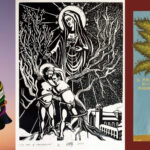Last Updated on November 16, 2024 by Kittredge Cherry
Police arrested 41 people at a Mexico City drag ball known as the Dance of the 41 Queers in a notorious police raid on Nov. 17-18, 1901. Now the Dance of the 41 is being reclaimed by the LGBTQ community, and same-sex marriage is legal in Mexico City. Cross-dressing balls are an international phenomenon that has continued for centuries, sometimes protected and often persecuted.
The Mexico City raid caused a huge scandal with lasting repercussions against LGBTQ people. The incident was widely reported and was used thereafter to justify years of police harassment, including more raids, blackmail, beatings and imprisonment. The number 41 entered popular culture in Mexico and continues to be used as a negative way to refer to gay men, evoking shame. The number is so taboo that in Mexico many buildings have no 41st floor, no army battalion is named 41, and many hotels and hospitals have no room 41.
About half of the people at the Dance of the 41 were described as men in female clothing, with European-style silk and satin dresses, elegant wigs, jewelry and make-up. The rest of the group wore expensive tailcoats and white gloves. Police raided the private house where the “transvestite ball” was underway. They never released the names of those arrested because they came from the upper-class elite of Mexican society. Reportedly a 42nd guest was allowed to go free because he was the president’s son-in-law. The guests at the Dance of the 41 are usually described as gay or homosexual, but recently some are identifying the cross-dressers as transgender.
 All the facts and the full context concerning the Dance of the 41 are examined by scholars and activists in the book “The Famous 41: Sexuality and Social Control in Mexico.”
All the facts and the full context concerning the Dance of the 41 are examined by scholars and activists in the book “The Famous 41: Sexuality and Social Control in Mexico.”
The lives and reputations of the 41 detainees were ruined. Those dressed in women’s clothing were forced to sweep the streets of Mexico City in female attire. Some were imprisoned and another group was forced into the army, where they dug ditches and cleaned latrines in the Yucatan. A lesbian gathering in Santa Maria was raided soon after on Dec. 4, 1901, but it received much less publicity.
The event is known in Spanish as simply as “el baile de los cuarenta y uno” (the dance of the forty-one) or with an added anti-gay insult “el baile de los cuarenta y uno maricones” (the dance of the forty-one queers).
“El baile de los 41” a Spanish-language feature film about the Dance of the 41, premiered in theaters in 2020. It was dubbed into English and premiered worldwide on Netflix in May 2021 as “Dance of the 41.” It was directed by David Pablos, written by Monika Revilla and filmed on location in Mexico City and Guadalajara. Even the video trailer is fascinating because it shows what the fateful ball might have been like.
Artists portray the Dance of the 41
A gay Mexican artist celebrates the Dance of the 41 in the painting at the top of this post: “El Baile de los 41” by Felix d’Eon. “I painted a scene from the party, in which the men enjoy a beautiful evening, of happiness, friendship, and love, before their lives are ruined forever, at the ‘Dance of the 41,’” he explains. Based in Mexico City, D’Eon describes himself as a “latinx painter and activist dedicated to the art of queer love, romance, and sensuality,” Prints of this and his other art are available at Art of Felix d’Eon Etsy shop.
“Los 41 Maricones” (The 41 Queers) by Jose Guadalupe Posada, 1901 (Wikipedia)
The vivid reports of the Dance of the 41 included a famous series of caricatures by popular Mexican artist Jose Guadalupe Posada. One of his satirical images is revitalized in a colorful painted drawing by Ralfka Gonzalez. He is a self-taught Chicano artist and gay Latino activist who divides his time between Oaxaca, Mexico and San Francisco. Gonzalez often paints Mexican and/or gay themes in a folk-art style. Some of the dancers wave rainbow fans in his “Los 41 Homosexuals de Mexico.” He intends to turn it into a limited-edition print to raise funds for queer causes.

“Los 41 Homosexuals de Mexico” by Ralfka Gonzalez
The mocking images also stand in contrast to the LGBT Stations of the Cross by Mary Button, whose paintings connect police raids of queer bars with the suffering of Jesus. The raid on the Dance of the 41 is an example of police harassment that happened in many countries and continues in some.
Dance of 41 is being reclaimed
Mexico’s 41 queer dancers were condemned as sinners, but they are included in the LGBTQ Saints series because their arrest and humiliation has contributed to LGBTQ visibility and pride. They represent the courage of all who were punished because of the queer ways that they lived and loved.
Mexico City became the first Latin American jurisdiction to legalize same-sex marriage in 2009 — before the U.S. Supreme Court legalized marriage equality. The law took effect on March 4, 2010.
A non-profit organization called “Honor 41” honors and celebrates Latinx LGBTQ individuals who are role models. Their English-language video on the Dance of the 41 gives an accessible overview of the history.
___
Related links:
Cross-dressing Balls (Wikipedia) | Baile de invertidos (Wikipedia Spanish)
To read this post in Spanish / en español, go to Santos Queer:
El baile de los cuarenta y uno: Recordando el momento en que la policía allanó un baile queer en México
___
Top image credit:
“El Baile de los 41” by Felix d’Eon. Prints are available at his Etsy shop.
___
This post is part of the LGBTQ Saints series series by Kittredge Cherry. The series celebrates religious and spiritual holidays, events in LGBTQ history, holy days, feast days, festivals, anniversaries, liturgical seasons and other occasions of special interest to lesbian, gay, bisexual, transgender and queer people of faith and allies.
This article was originally published on Q Spirit in November 2016, expanded with new material over time, and most recently updated on Nov. 16, 2024.























Just a detail: those fine gentlemen weren’t wearing tuxedos, which would have been unacceptable in 1901, but tailcoats.
Other than that, thank you for your article!
Thanks! I’ll make that correction. I looked it up and discovered that tailcoats are more elegant than tuxedos.